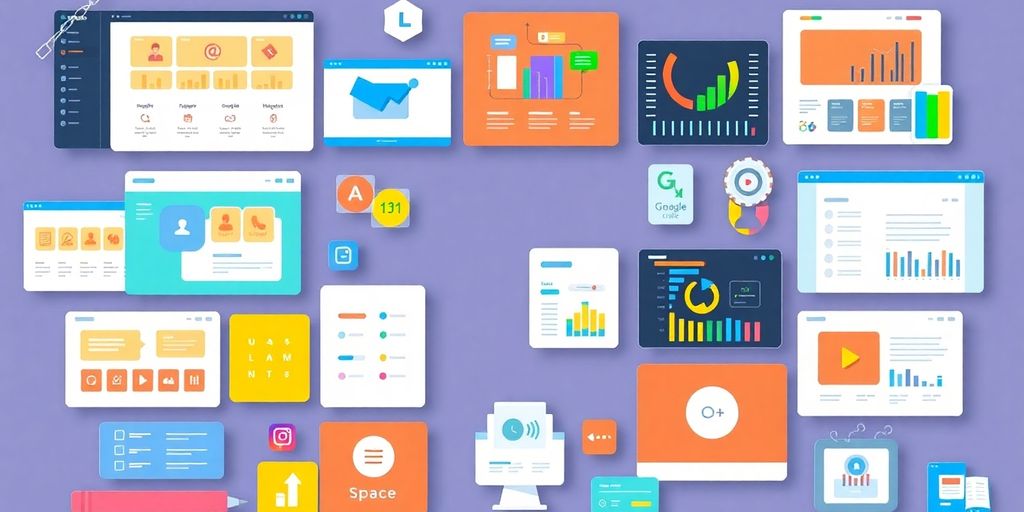Slack Alternatives: Better Collaboration for Your Team

In today’s fast-paced work environment, effective communication is key. While Slack has been a popular choice for many teams, it does come with its own set of challenges. From high costs to information overload, some teams are now seeking better options. If you’re looking to improve collaboration without breaking the bank, exploring Slack alternatives might be the way to go. Let’s take a look at some of the limitations of Slack and what alternatives can offer to enhance your team’s productivity.
Key Takeaways
- Slack can be pricey, especially for larger teams.
- Information overload in Slack can hinder productivity.
- Security features in Slack may not meet all business needs.
- Alternatives like Microsoft Teams and Google Chat offer better integration for users already in their ecosystems.
- Switching to a different platform can lead to improved collaboration and cost savings.
Understanding The Limitations Of Slack
Slack has become a staple in many workplaces, but it’s not without its drawbacks. While it offers a convenient way to communicate, some limitations can hinder productivity and even pose risks. Let’s explore some of the key issues that might make you consider Slack alternatives.
High Pricing Concerns
One of the biggest complaints about Slack is its pricing structure. While it offers a free plan, it’s often too limited for growing teams. The paid plans can become quite expensive, especially for larger organizations. This can be a significant burden, particularly for startups or small businesses operating on tight budgets. It’s worth evaluating whether the features offered justify the cost, or if a more cost-effective solution might be a better fit.
Information Overload Issues
Slack’s real-time messaging can quickly become overwhelming. With multiple channels, direct messages, and constant notifications, it’s easy to get lost in the noise. This can lead to notification fatigue, decreased focus, and missed important information. The sheer volume of messages can make it difficult to prioritize tasks and stay on top of critical updates.
It’s easy to get caught up in endless conversations and lose sight of your actual work. Finding important information, like a specific file shared weeks ago, can feel like searching for a needle in a haystack.
Here are some common issues related to information overload:
- Difficulty prioritizing messages
- Increased stress and anxiety
- Reduced productivity due to constant interruptions
Security Gaps In Communication
For teams handling sensitive information, Slack’s security features might not be sufficient. While it offers some security measures, it may lack the advanced features required by regulated industries. Concerns about data privacy and compliance can be a major factor in considering alternatives. Some companies require features like end-to-end encryption or more granular control over data access, which Slack may not provide. This is especially important when dealing with confidential client data or intellectual property. It’s important to consider if Slack can incorporate additional security features needed for your specific industry.
Exploring Top Slack Alternatives
Slack is great, but it’s not the only game in town. Lots of teams are finding that other platforms fit their needs better. Maybe it’s about cost, maybe it’s about features, or maybe it’s just about finding something that clicks with your team’s workflow. Let’s check out some of the top contenders.
Microsoft Teams For Enhanced Collaboration
Microsoft Teams is a big player, especially if your company already uses Microsoft 365. It’s more than just chat; it’s a full-blown collaboration hub. You get chat, video conferencing, file storage, and integration with all those familiar Microsoft apps like Word, Excel, and PowerPoint. For organizations deeply invested in the Microsoft ecosystem, it’s a pretty compelling option. It might be a good idea to explore ClickUp as well.
Google Chat For Seamless Integration
If your team lives and breathes Google Workspace, then Google Chat is a natural fit. It’s tightly integrated with Gmail, Google Drive, Google Meet, and all the other Google apps you probably use every day. It’s simple, straightforward, and gets the job done. Plus, it’s usually included with your Google Workspace subscription, so there’s no extra cost. It’s a solid choice for teams that want a no-fuss, integrated communication platform. Google Chat is a great alternative.
Rocket.Chat As An Open Source Option
Rocket.Chat is where things get interesting. It’s an open-source platform, which means you have a ton of flexibility and control. You can host it on your own servers, customize it to your heart’s content, and even contribute to the project’s development. It’s a great option for teams that need advanced security features, want to avoid vendor lock-in, or just like the idea of supporting open-source software. It’s not as polished as some of the commercial options, but the flexibility is hard to beat. Rocket.Chat offers incorporate additional security features.
Switching to an alternative platform can feel daunting, but the potential benefits are significant. Consider your team’s specific needs, budget, and technical capabilities when making your decision. Don’t be afraid to try out a few different options before settling on the one that works best for you.
Key Features To Look For In Collaboration Tools

Choosing the right collaboration tool can feel like a big task. There are so many options, and each one promises to be the best. But what really matters? It boils down to a few key features that can make or break your team’s experience. Let’s take a look at what you should be prioritizing.
User-Friendly Interface
A clean and intuitive interface is non-negotiable. If your team can’t figure out how to use the tool, they simply won’t use it. It needs to be easy to navigate, with features that are simple to find and understand. Think about it: time spent wrestling with a complicated interface is time not spent on actual work. A good interface will have a short learning curve and will allow users to quickly adopt the collaboration software.
Robust Security Features
Security is a big deal, especially when you’re dealing with sensitive information. You need to make sure the platform you choose has strong security measures in place. This includes things like:
- End-to-end encryption
- Multi-factor authentication
- Data loss prevention
It’s better to be safe than sorry. Look for platforms that are transparent about their security practices and comply with industry standards. Don’t be afraid to ask tough questions about how they protect your data.
Integration Capabilities With Other Tools
No collaboration tool exists in a vacuum. It needs to play well with the other tools your team uses every day. Think about the apps you rely on most – project management software, file storage, calendar apps, etc. The more integrations a platform offers, the easier it will be to streamline your workflow. For example, integrating with time-tracking software can help manage tasks more efficiently. Here’s a quick example of how integrations can impact productivity:
| Integration | Benefit |
|---|---|
| Project Management | Centralized task management and tracking |
| File Storage | Easy access to shared documents |
| Calendar | Simplified scheduling and reminders |
Having these integrations can really improve team collaboration.
Benefits Of Switching To Alternative Platforms
Switching from Slack to an alternative platform can bring a wave of improvements to how your team operates. It’s not just about finding something different; it’s about finding something better suited to your specific needs. The right platform can significantly impact your team’s efficiency, budget, and overall satisfaction.
Improved Team Productivity
Alternative platforms often come with features designed to streamline workflows and boost productivity. Think about task management integrations, more intuitive search functions, or even just a cleaner, less cluttered interface. These small changes can add up to big gains in how efficiently your team works. For example, some platforms offer better thread management, making it easier to follow conversations and reducing the time spent searching for information. A well-organized communication tool can be a game-changer.
Cost-Effectiveness
Slack’s pricing can be a sticking point for many teams, especially as they grow. Alternative platforms often offer more competitive pricing models, with some even providing more generous free plans or lower costs for premium features. It’s worth doing a value for money analysis to see how much you could save by switching. The money saved could be reinvested in other areas of your business.
Better File Sharing Options
File sharing is a critical part of team collaboration, and some Slack alternatives handle it more effectively. This could mean larger file size limits, more robust version control, or tighter integration with cloud storage services. Having a seamless way to share and manage files can prevent bottlenecks and keep projects moving forward. Some platforms also offer advanced features like automatic file indexing and search, making it easier to find what you need, when you need it.
Making the switch to a new platform isn’t always easy, but the potential benefits are significant. By carefully evaluating your team’s needs and exploring the available options, you can find a solution that improves productivity, reduces costs, and enhances collaboration.
Comparing Pricing Models Of Collaboration Tools

It’s easy to get lost in the features of different collaboration platforms, but the pricing model is where the rubber meets the road. Understanding how these tools charge can significantly impact your budget and overall value. Let’s break down the common pricing approaches.
Free Plans And Their Limitations
Many collaboration tools offer free plans to attract users. These plans are great for small teams or individuals who want to test the waters. However, they often come with limitations:
- Limited storage space for files.
- Restrictions on the number of users.
- Fewer integrations with other apps.
- Basic support options.
Free plans are a good starting point, but be aware of the constraints. As your team grows or your needs become more complex, you’ll likely need to upgrade to a paid plan.
Monthly Subscription Costs
Most collaboration platforms offer monthly subscription plans, typically priced per user. This model provides flexibility, allowing you to scale up or down as needed. Prices can vary widely depending on the features included. For example, Microsoft Teams’ paid plans start around $4 per user per month, while other platforms like Front can range much higher, depending on the tier. Here’s a quick look at some examples:
| Platform | Monthly Cost (per user) | Notes |
|---|---|---|
| Microsoft Teams | $4+ | Integrates with Office 365 |
| Flock | $6+ | Easy-to-use collaboration tool |
| Zoho Cliq | $2+ | Customizable domain, brand assets, themes |
Value For Money Analysis
Ultimately, the best pricing model depends on your team’s specific needs and budget. Consider these factors when evaluating value for money:
- Features: Does the plan include the features your team needs, such as video conferencing, file sharing, and task management?
- Scalability: Can the plan accommodate your team’s growth without significant cost increases?
- Integrations: Does the platform integrate with the other tools your team uses?
- Support: What level of support is included in the plan?
It’s worth noting that some platforms, like Ryver, offer flat-rate pricing for a certain number of users, which can be more cost-effective for smaller teams. Others, like Wire, offer custom pricing for larger organizations with specific security needs. Carefully evaluate software companies to find the best fit.
User Experiences With Slack Alternatives
Case Studies Of Successful Transitions
Switching from one collaboration platform to another can feel like a big deal, but many teams have made the leap and found success. For example, a marketing team I know switched to Microsoft Teams primarily because of its tighter integration with the Office 365 suite they were already using. They reported a significant improvement in file sharing and version control, which had been a constant headache with Slack. Another company, a small startup, moved to Rocket.Chat to take advantage of its open-source nature and greater customization options. They needed specific security features that Slack didn’t offer, and Rocket.Chat allowed them to tailor the platform to their exact needs. These transitions often require initial effort in training and setup, but the long-term benefits can be substantial.
Feedback From Teams
User feedback on Slack alternatives is pretty diverse, but some common themes emerge. Many users appreciate the cost savings associated with platforms like Mattermost or Zulip, especially compared to Slack’s pricing structure. Others highlight the improved organization and focus they experience with tools that offer threaded conversations or more granular notification controls. However, it’s not all sunshine and roses. Some teams miss Slack’s user-friendly interface or the extensive app integrations available in its marketplace. The key seems to be finding a platform that aligns with your team’s specific needs and priorities.
Common Challenges Faced
Moving to a new collaboration tool isn’t always easy. Here are some common hurdles teams face:
- Resistance to change: People get used to their tools, and switching can disrupt established workflows.
- Data migration: Moving existing conversations and files from Slack to a new platform can be complex and time-consuming.
- Feature parity: Not all platforms offer the exact same features as Slack, so teams may need to adjust their processes.
One of the biggest challenges is getting everyone on board. It’s important to communicate the reasons for the switch clearly and provide adequate training and support to help people adapt. Without buy-in from the team, even the best alternative can fall flat.
To mitigate these challenges, it’s a good idea to:
- Involve team members in the selection process.
- Plan the migration carefully.
- Provide ongoing support and training.
Future Trends In Team Collaboration Software
Rise Of Hybrid Work Models
Hybrid work is here to stay, and collaboration tools are adapting fast. We’re seeing a big push for features that make it easier for teams to work together, no matter where they are. This means better video conferencing, more robust file sharing, and tools that help bridge the gap between in-office and remote workers. Think interactive whiteboards that everyone can use at the same time, regardless of location, and improved ways to manage different time zones and work schedules. It’s all about making sure everyone feels connected and productive, even when they’re not in the same room. The focus is on creating a unified experience that supports flexibility and inclusivity.
Increased Demand For Customization
One size doesn’t fit all, especially when it comes to team collaboration. More and more teams want tools that they can tweak to fit their specific needs. This could mean anything from custom workflows and integrations to branding options that make the platform feel like an extension of their own company culture. The ability to tailor the collaboration experience is becoming a major selling point. People want to use the tools that work best for them, not the other way around.
Integration Of AI In Communication Tools
AI is starting to play a bigger role in team collaboration, and it’s only going to get more prevalent. We’re already seeing AI-powered features like smart summaries of meetings, automated task assignments, and even sentiment analysis to gauge team morale. But that’s just the beginning. In the future, expect to see AI helping with things like:
- Predictive analysis to identify potential roadblocks in projects.
- Personalized recommendations for resources and experts.
- Automated translation for global teams.
- Enhanced security features to detect and prevent threats.
The integration of AI aims to streamline workflows, reduce manual tasks, and provide insights that help teams work smarter, not harder. It’s about augmenting human capabilities and making collaboration more efficient and effective. The goal is to make data collaboration more accessible.
Here’s a quick look at how AI might impact different aspects of team collaboration:
| Feature | AI Enhancement |
|---|---|
| Meeting Summaries | Automated key point extraction and action items |
| Task Management | Intelligent task assignment and prioritization |
| Communication | Real-time translation and sentiment analysis |
Wrapping It Up
In the end, finding the right Slack alternative can really change how your team communicates and works together. Each tool has its own strengths and weaknesses, so it’s important to think about what your team needs most. Whether it’s better security, easier file sharing, or just a more user-friendly interface, there’s definitely an option out there that can fit the bill. Take the time to explore these alternatives, and you might just discover a solution that makes collaboration smoother and more effective for everyone involved.
Frequently Asked Questions
What are some common problems with Slack?
Slack can be expensive, has too many notifications, and lacks strong security features.
What are good alternatives to Slack?
Some great alternatives include Microsoft Teams, Google Chat, and Rocket.Chat.
Why should I consider switching from Slack?
Switching can lead to better team productivity, lower costs, and easier file sharing.
How do pricing plans for collaboration tools compare?
Many tools offer free plans, but paid plans can vary widely in cost and features.
What features should I look for in a collaboration tool?
Look for an easy-to-use interface, strong security, and the ability to connect with other tools.
What trends are shaping team collaboration software?
Trends include more hybrid work options, customization needs, and the use of AI in communication.








Responses